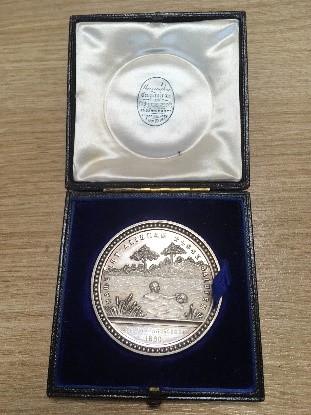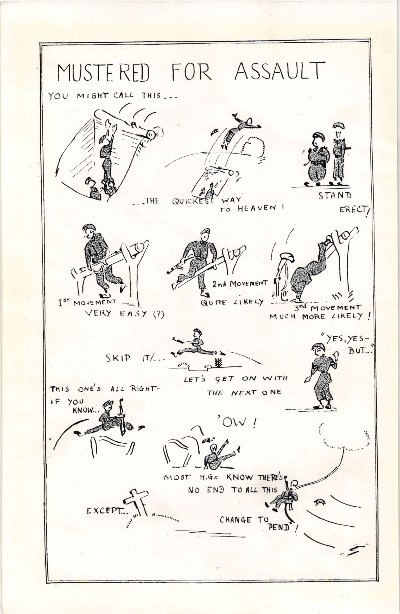Remembrance of Things Past
By Archive Volunteer, Karen Lush
 Here in the Archive we have just come to the end of months of work on WW1, culminating in last November’s Armistice centenary commemorations. For me, this ran from the inspiring (researching the heroic deeds and noble sacrifices of OMTs in the trenches) to the interminable (gluing the names of each of those roughly 1,500 OMTs onto balsa wood crosses and batons for the “Every one remembered” display in the quad. No, honestly, it was an honour). The Taylorian proved a rich source of information, with numerous obituaries, medal citations and stories from the front, but I was also surprised to discover what a strong online presence those long-dead OMTs have. There were very few names for whom I couldn’t find at least something on the internet, whether it was in newspapers, books, regimental histories, or army museum sites. I had the poignant sense that for some of these young men, this was perhaps the first time in decades that anyone had taken active notice of their names and stories, and that those stories would now lapse gently back to sleep for another hundred years.
Here in the Archive we have just come to the end of months of work on WW1, culminating in last November’s Armistice centenary commemorations. For me, this ran from the inspiring (researching the heroic deeds and noble sacrifices of OMTs in the trenches) to the interminable (gluing the names of each of those roughly 1,500 OMTs onto balsa wood crosses and batons for the “Every one remembered” display in the quad. No, honestly, it was an honour). The Taylorian proved a rich source of information, with numerous obituaries, medal citations and stories from the front, but I was also surprised to discover what a strong online presence those long-dead OMTs have. There were very few names for whom I couldn’t find at least something on the internet, whether it was in newspapers, books, regimental histories, or army museum sites. I had the poignant sense that for some of these young men, this was perhaps the first time in decades that anyone had taken active notice of their names and stories, and that those stories would now lapse gently back to sleep for another hundred years.
 One fascinating discovery from this period was the reminiscences of H.S. Le Marquand, who was at the school from 1906-1914. Le Marquand filled over thirty pages with his gimlet-eyed descriptions of masters, subjects, sports and fellow pupils. Mr Rieu, one of the MTS masters who served and died in WW1, was “unique in my memory of masters as the first and indeed the only one to make a lesson enjoyable.” He also beat JC Barrett, one of the school’s five future VCs, to win the Royal Humane Society Medal ‘for proficiency in swimming exercise with reference to saving life from drowning’. Corporal punishment was of course an ever-present feature: “We were all caned frequently but took little note of it. Seeing others suffer was always a pleasing interlude in the interminable Latin periods. Caning was preferred to detention on Wednesday afternoons.” Despite his complaints about the incompetent masters, boring lessons and inadequate facilities, he felt the boys “formed a deep love for and pride in the school, which referred to all aspects of the school’s history and achievements in learning and sport. This is shown in the unrivalled success of the OMT Society.”
One fascinating discovery from this period was the reminiscences of H.S. Le Marquand, who was at the school from 1906-1914. Le Marquand filled over thirty pages with his gimlet-eyed descriptions of masters, subjects, sports and fellow pupils. Mr Rieu, one of the MTS masters who served and died in WW1, was “unique in my memory of masters as the first and indeed the only one to make a lesson enjoyable.” He also beat JC Barrett, one of the school’s five future VCs, to win the Royal Humane Society Medal ‘for proficiency in swimming exercise with reference to saving life from drowning’. Corporal punishment was of course an ever-present feature: “We were all caned frequently but took little note of it. Seeing others suffer was always a pleasing interlude in the interminable Latin periods. Caning was preferred to detention on Wednesday afternoons.” Despite his complaints about the incompetent masters, boring lessons and inadequate facilities, he felt the boys “formed a deep love for and pride in the school, which referred to all aspects of the school’s history and achievements in learning and sport. This is shown in the unrivalled success of the OMT Society.”
 Le Marquand became a doctor, served in both wars, and contributed the Le Marquand Prize for Biology which is still awarded to this day (now called the Le Marquand Prize for Field Ecology). His vivid memoirs are a uniquely valuable historical record, and I hope to type them up when I have time so that others can access and enjoy them. I would encourage any OMTs to think about contributing their own reminiscences. An account of life here in, say, the 1960s or 1980s would be just as fascinating to future generations.
Le Marquand became a doctor, served in both wars, and contributed the Le Marquand Prize for Biology which is still awarded to this day (now called the Le Marquand Prize for Field Ecology). His vivid memoirs are a uniquely valuable historical record, and I hope to type them up when I have time so that others can access and enjoy them. I would encourage any OMTs to think about contributing their own reminiscences. An account of life here in, say, the 1960s or 1980s would be just as fascinating to future generations.
Just as we were packing WW1 away, we received an inquiry from an author wanting to know about the school during WW2. I went eagerly back to the Taylorian, only to find an almost total dearth of war-related information. Someone took the decision that it was unfair to focus on a few individuals when many were serving, and so nothing was printed about serving OMTs beyond a list of names, ranks and regiments. My counterpart in 2045 is going to have a much harder job than I did with WW1. Nonetheless, we managed to discover that MTS produced at least two Bletchley code-breakers, and had its own Home Guard unit and an Air Training Corps.
Another recent task was to catalogue all the school play programmes going back to the 1920s. If you once scaled the dramatic heights of Pinter or Brecht, or had more fun in Grease or South Pacific, then we’ve got the evidence in Box 77.